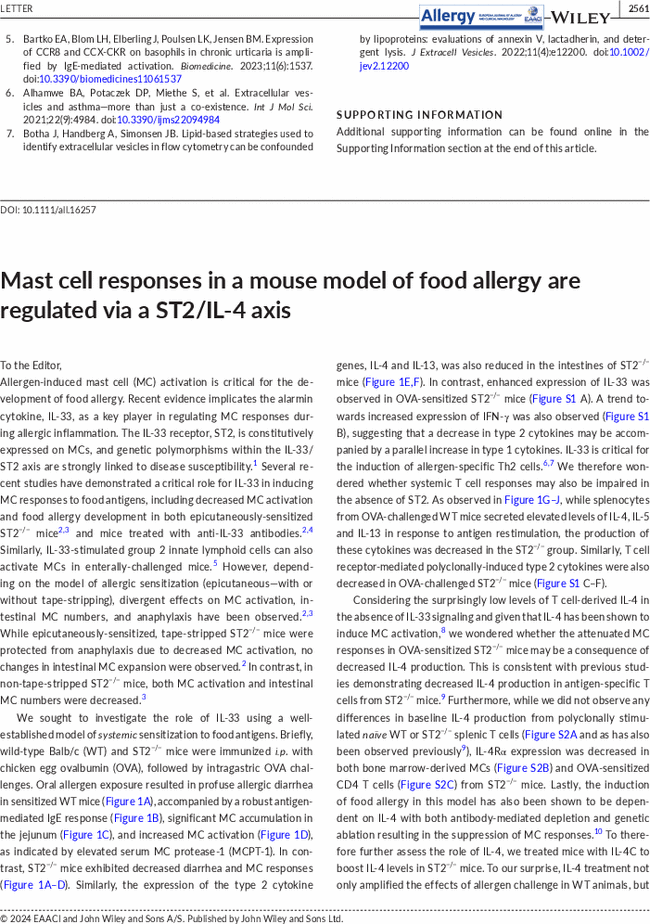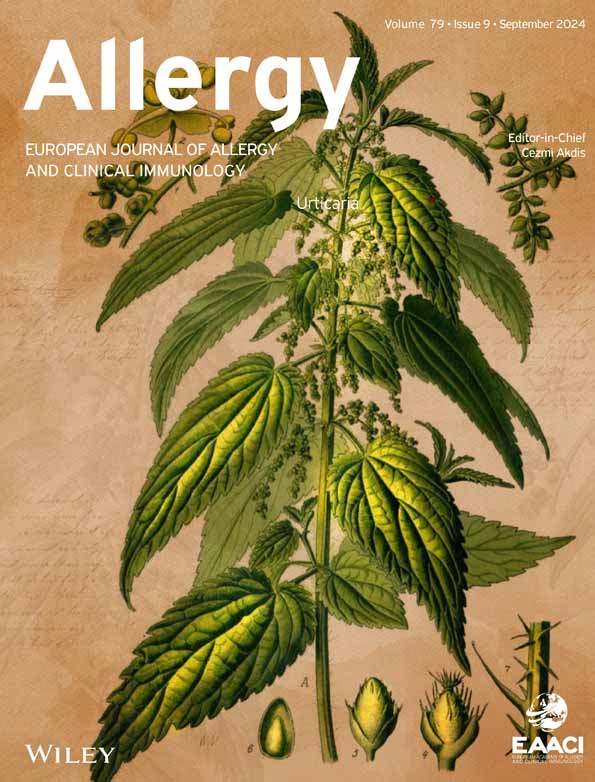Mast cell responses in a mouse model of food allergy are regulated via a ST2/IL-4 axis
Saurav Ranjitkar
Department of Nutritional Sciences, University of Connecticut, Storrs, Connecticut, USA
Search for more papers by this authorDylan Krajewski
Department of Immunology, University of Connecticut, Farmington, Connecticut, USA
Search for more papers by this authorCaitlin Tedeschi
Department of Nutritional Sciences, University of Connecticut, Storrs, Connecticut, USA
Search for more papers by this authorNicole Maldonado Perez
Department of Nutritional Sciences, University of Connecticut, Storrs, Connecticut, USA
Search for more papers by this authorNathan Jordan
Department of Nutritional Sciences, University of Connecticut, Storrs, Connecticut, USA
Search for more papers by this authorKelly Gregory
Pioneer Valley Life Sciences Institute, Baystate Medical Center, Springfield, Massachusetts, USA
Search for more papers by this authorSallie S. Schneider
Pioneer Valley Life Sciences Institute, Baystate Medical Center, Springfield, Massachusetts, USA
Search for more papers by this authorCorresponding Author
Clinton B. Mathias
Department of Nutritional Sciences, University of Connecticut, Storrs, Connecticut, USA
Correspondence
Clinton B. Mathias, Department of Nutritional Sciences, University of Connecticut, Storrs, CT 06269, USA.
Email: [email protected]
Search for more papers by this authorSaurav Ranjitkar
Department of Nutritional Sciences, University of Connecticut, Storrs, Connecticut, USA
Search for more papers by this authorDylan Krajewski
Department of Immunology, University of Connecticut, Farmington, Connecticut, USA
Search for more papers by this authorCaitlin Tedeschi
Department of Nutritional Sciences, University of Connecticut, Storrs, Connecticut, USA
Search for more papers by this authorNicole Maldonado Perez
Department of Nutritional Sciences, University of Connecticut, Storrs, Connecticut, USA
Search for more papers by this authorNathan Jordan
Department of Nutritional Sciences, University of Connecticut, Storrs, Connecticut, USA
Search for more papers by this authorKelly Gregory
Pioneer Valley Life Sciences Institute, Baystate Medical Center, Springfield, Massachusetts, USA
Search for more papers by this authorSallie S. Schneider
Pioneer Valley Life Sciences Institute, Baystate Medical Center, Springfield, Massachusetts, USA
Search for more papers by this authorCorresponding Author
Clinton B. Mathias
Department of Nutritional Sciences, University of Connecticut, Storrs, Connecticut, USA
Correspondence
Clinton B. Mathias, Department of Nutritional Sciences, University of Connecticut, Storrs, CT 06269, USA.
Email: [email protected]
Search for more papers by this author
Open Research
DATA AVAILABILITY STATEMENT
Research data are not shared.
Supporting Information
| Filename | Description |
|---|---|
| all16257-sup-0001-supinfo.docxWord 2007 document , 721.7 KB |
Data S1. |
Please note: The publisher is not responsible for the content or functionality of any supporting information supplied by the authors. Any queries (other than missing content) should be directed to the corresponding author for the article.
REFERENCES
- 1Cayrol C, Girard JP. Interleukin-33 (IL-33): a nuclear cytokine from the IL-1 family. Immunol Rev. 2018; 281(1): 154-168.
- 2Galand C, Leyva-Castillo JM, Yoon J, et al. IL-33 promotes food anaphylaxis in epicutaneously sensitized mice by targeting mast cells. J Allergy Clin Immunol. 2016; 138(5): 1356-1366.
- 3Brandt EB, Ruff BP, Filuta AL, Chang WC, Shik D, Khurana Hershey GK. Thymic stromal lymphopoietin rather than IL-33 drives food allergy after epicutaneous sensitization to food allergen. J Allergy Clin Immunol. 2023; 151(6): 1660-1666 e1664.
- 4Khodoun MV, Tomar S, Tocker JE, Wang YH, Finkelman FD. Prevention of food allergy development and suppression of established food allergy by neutralization of thymic stromal lymphopoietin, IL-25, and IL-33. J Allergy Clin Immunol. 2018; 141(1): 171-179 e171.
- 5Noval Rivas M, Burton OT, Oettgen HC, Chatila T. IL-4 production by group 2 innate lymphoid cells promotes food allergy by blocking regulatory T-cell function. J Allergy Clin Immunol. 2016; 138(3): 801-811 e809.
- 6Lohning M, Stroehmann A, Coyle AJ, et al. T1/ST2 is preferentially expressed on murine Th2 cells, independent of interleukin 4, interleukin 5, and interleukin 10, and important for Th2 effector function. Proc Natl Acad Sci USA. 1998; 95(12): 6930-6935.
- 7Schmitz J, Owyang A, Oldham E, et al. IL-33, an interleukin-1-like cytokine that signals via the IL-1 receptor-related protein ST2 and induces T helper type 2-associated cytokines. Immunity. 2005; 23(5): 479-490.
- 8Burton OT, Darling AR, Zhou JS, et al. Direct effects of IL-4 on mast cells drive their intestinal expansion and increase susceptibility to anaphylaxis in a murine model of food allergy. Mucosal Immunol. 2013; 6(4): 740-750.
- 9Townsend MJ, Fallon PG, Matthews DJ, Jolin HE, McKenzie AN. T1/ST2-deficient mice demonstrate the importance of T1/ST2 in developing primary T helper cell type 2 responses. J Exp Med. 2000; 191(6): 1069-1076.
- 10Brandt EB, Munitz A, Orekov T, et al. Targeting IL-4/IL-13 signaling to alleviate oral allergen-induced diarrhea. J Allergy Clin Immunol. 2009; 123(1): 53-58.
- 11Chinthrajah S, Cao S, Liu C, et al. Phase 2a randomized, placebo-controlled study of anti-IL-33 in peanut allergy. JCI Insight. 2019; 4(22):e131347.




